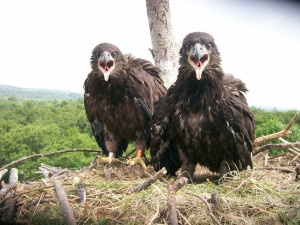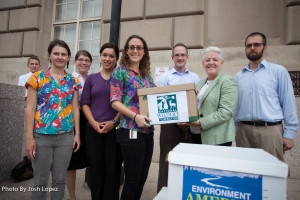We have much more to do and your continued support is needed now more than ever.
Bald Eagle Comeback Highlights Need for McCarthy’s Leadership at EPA

Success Story
First, the good news. Massachusetts announced this week that bald eagles, once completely wiped out in the state, are now soaring to a strong comeback:
Officials from the Department of Fish and Game (DFG) verified 30 active nests in the Commonwealth, including eight nests along the Connecticut River, six at the Quabbin Reservoir and four along the Merrimack River during Massachusetts’ first Bald Eagle nesting survey. The survey, coordinated by the DFG’s Division of Fisheries and Wildlife (MassWildlife) and involving agency staff and 35 volunteers, was conducted on April 5, 2013.
In addition to the principal bald eagle nesting territories along the Connecticut and Merrimack rivers and at Quabbin Reservoir, other active nests were observed at Wachusett Reservoir, and in the towns of Framingham, Brookfield, Pittsfield, Webster, Middleborough, Fall River and Plymouth. One nest failure was reported at Assawompsett Pond in Lakeville, where the wind blew a nest and two eggs out of the nest tree in early April. Additional eagle sightings were reported in Arlington, Carver, Lunenburg, Russell, Sandisfield and along the Housatonic River.
Bald eagles, the largest bird of prey native to Massachusetts with a body length of about 3 feet and a wingspan of up to seven feet, have increased in numbers in Massachusetts since being reintroduced to the Quabbin Reservoir between 1982 and 1988. The species was down listed from Endangered to Threatened status in Massachusetts in 2011 and removed from the federal endangered species list in 2007.
To report a bald eagle sighting in Massachusetts, email the Division of Fisheries and Wildlife’s Natural Heritage & Endangered Species Program natural.heritage@state.ma.us.
Mercury’s Threat to Bald Eagles
Bald eagles, our national symbol & once common across North America, were pushed to the brink of extinction by the pesticide DDT, pollution from heavy metals like mercury, hunting, habitat loss, and other factors. While we stopped using DDT, banned hunting, and restored what Aldo Leopold called our land ethic, mercury pollution remains a major threat to bald eagles.
Heavy metals are emitted through the burning of fossil fuels and are washed to our waterways, then bioaccumulate in predators at the top of the food chain:
- If a small fish eats 50 mercury contaminated plants.
- And a large fish eats 100 small fish
- And an eagle eats 100 large fish.
- 50 x 100 x 100 = 250,000. The concentration of mercury in the eagle is 250,000 times larger than it was in the plankton.
It’s not uncommon for sick bald eagles to test positive for mercury poisoning.

A Fighter for Wildlife
That’s why it’s so critical for America’s wildlife that Gina McCarthy is confirmed as Environmental Protection Agency administrator as soon as possible. She has a long track record of experience limiting mercury pollution at both the state and federal levels, working for both Democrats and Republicans. Appointed by Gov. William Weld (R-MA) to be executive director of the administrative council at the Massachusetts Executive Office of Environmental Affairs, McCarthy ran the nation’s largest pollution prevention program, called the Massachusetts Toxics Use Reduction Program.
Then working as head of the Environmental Protection Agency Office of Air and Radiation, McCarthy oversaw development of the new Mercury and Air Toxic Standards (MATS) setting emission limits for power plants in order to reduce mercury, arsenic and other toxic air pollution. The MATS rule will not only protect wildlife, it will deliver huge public health benefits for Americans, preventing up to 11,000 premature deaths, 4,700 heart attacks and 130,000 asthma attacks every single year.
But polluter allies in Congress are working hard to block Gina McCarthy’s confirmation. Republicans on the Senate Environment & Public Works Committee refused to even show up for a vote, delaying McCarthy’s confirmation indefinitely. “Given Gina McCarthy’s long record of non-partisan public service, it’s inexcusable for her nomination to be politicized by senators prioritizing industrial polluters over public health protection,” said Larry Schweiger, president & CEO of the National Wildlife Federation. Some of those senators did, however, make time that same morning for fundraisers with lobbyists for big polluters like BP & Exxon Mobil.






















